The Information Technology and Innovation Foundation (ITIF) is an independent, nonprofit, nonpartisan research and educational institute focusing on the intersection of technological innovation and public policy. Recognized by its peers in the think tank community as the global center of excellence for science and technology policy, ITIF’s mission is to formulate and promote policy solutions that accelerate innovation and boost productivity to spur growth, opportunity, and progress.
Author: admin
-

Will Smith unable to maintain lifestyle amid financial woes: Source
Photo: Will Smith unable to maintain lifestyle amid financial woes: Source Will Smith is reportedly going through financial woes.
Ever since the Chris Rock Academy Award drama took place, the acting sensation has reportedly lost major gigs.
According to the latest findings of RadarOnline.com, the A-listed actor’s earning power has taken a major hit.
“Since the Oscars incident, the money’s been going out way faster than it’s coming in,” a source tipped.
For context, at the 2022 Oscars, the 56-year-old American actor and rapper slapped Chris Rock in response to an unscripted joke he cracked about Will Smith’s now-estranged wife, Jada Pinkett Smith’s, shaved head.
They went on to mention his blockbuster flick, “Will’s still picking up some checks, and Bad Boys: Ride or Die performed decently, but it’s nowhere close to covering the kind of life he’s used to.”
“He might still have more in the bank than most people in the world, but he’s got a lifestyle to match, with a massive bank of staff to maintain his house and his – now failing – brand,” the spy confided.
Reportedly, Will is separate for work so that he can pay his bills as the mole concluded by saying, “His outgoings are in danger of killing his savings with no more big movie checks on offer like the old days.”
Continue Reading
-

Analysts: the Galaxy Z Fold7 and Z Flip7 are headed for record-breaking pre-orders in Korea
Analysts are keeping a close eye on pre-orders for the Samsung Galaxy Z Fold7 and Galaxy Z Flip7 in South Korea and they are forecasting record-breaking numbers. Looking back at the last couple of generations, the Z Fold5 and Z Flip5 set the record with over 1 million pre-orders (1.02 million, specifically) back in 2023. The Z Fold6 and Z Flip6 from last year failed to reach that benchmark.
Pre-order reservations on Samsung.com reached 160,000 in the 14 days since reservations opened on June 24. This was before the official reveal on July 9, but is used by analysts as a starting point to calculate record-breaking domestic demand for the new foldables. There’s no mention of the Galaxy Z Flip7 FE, but maybe its numbers are being rolled into Z Flip7 stats.

Samsung Galaxy Z Fold7 and Galaxy Z Flip7It should be noted that this prediction is for the South Korean market, which is affected by factors not related to the quality and upgrades of the new Z foldables.
For example, SK Telecom was recently hit by a hacking incident, which is driving subscribers away. KT and LG U+ are happy to snatch up those subscribers. SK Telecom is offering attractive deals on the Z Fold7 and Z Flip7 to try and claw back some market share.
Related to that, Korea repealed the Device Distribution Improvement Act, which mandated that details of carrier subsidy deals should be made public. Prior to that, carriers were offering up to KRW 500,000 in subsidies – with the most recent changes, the subsidies can go up as carriers try to attract new subscribers. Samsung is happy for the extra business, of course.
Source (in Korean)
Samsung Galaxy Z Fold7
Samsung Galaxy Z Flip7
Samsung Galaxy Z Flip7 FE 5G
Continue Reading
-
Punjab speaker halts action against suspended PTI MPAs
Listen to article The Punjab government has decided to halt further punitive action against suspended Pakistan Tehreek-e-Insaf (PTI) Members of Provincial Aseembly (MPAs) amid ongoing negotiations.
The opposition lawmakers were suspended by Punjab Assembly Speaker Malik Muhammad Ahmad Khan following chaotic scenes in the House on June 27, when members from both sides of the aisle engaged in a physical altercation during Chief Minister Maryam Nawaz’s address.
In an effort to resolve the standoff, the speaker had constituted an eight-member negotiation committee comprising members from both the treasury and opposition.
The committee held two rounds of talks, the latest on Sunday evening. While no formal breakthrough was achieved in those meetings, government sources indicated on Tuesday that some progress had been made, prompting a decision to de-escalate.
Read More: No headway in talks over suspended PTI MPAs; dialogue to continue
According to Express News, the speaker has directed the Assembly secretariat and government members to suspend any further action against the opposition until the talks yield conclusive results.
The Assembly secretariat had initially planned additional measures against 19 suspended opposition MPAs, including fines imposed on 10 of them for alleged vandalism in the House. These fines, along with second notices and deductions from salaries, have now been paused.
Sources said that the suspended lawmakers had been collectively fined over Rs20 million and were previously given a one-week deadline to pay or face stricter action. However, these enforcement measures have now been withheld pending the outcome of the ongoing dialogue.
In addition, the government has also suspended plans to table no-confidence motions against nine more opposition chairpersons of standing committees. Previously, four such chairpersons had already been removed through similar motions.
According to government sources, a total of 13 opposition lawmakers were slated to be removed from their committee positions as part of the disciplinary response to the June 27 events. That plan, too, has been put on hold in light of the negotiations.
Continue Reading
-

Webb spots ‘Infinity Galaxy’ that sheds light on black hole formation
Discoveries keep pouring out of the James Webb Space Telescope (JWST). Researchers observed an unusual cluster, which they dubbed the Infinity Galaxy. It appears to support a leading theory on how some supermassive black holes form.
Although “Infinity Galaxy” sounds like a place Thanos would hang out, it merely describes its appearance. Two compact, red nuclei, each surrounded by a ring, give the cluster the shape of an infinity symbol.
What’s inside is more interesting. (After all, this is a much lower-res image than some of the eye candy the Webb telescope has yielded.) Researchers believe the Infinity Galaxy formed when two spiral galaxies (the nuclei in the image) collided. Between them lies a young supermassive black hole within an enormous cloud of gas.
Supermassive black holes can range from hundreds of thousands of times the size of our sun to millions or billions of times its size. This one is about a million times as big.

The Infinity Galaxy, overlaid with a contour map indicating the supermassive black hole (NASA / JWST) The Infinity Galaxy lends weight to the direct collapse theory of black hole formation. As you probably know, most black holes form when massive stars collapse. The presence of supermassive ones is harder to explain.
One theory proposes that smaller black holes merge over time to form a supermassive one. The problem there is that some supermassive black holes formed soon after the Big Bang. So, scientists think some supermassive ones form instead from the collapse of gas clouds, much like the one we see here. The Infinity Galaxy may be the best evidence yet for that direct collapse hypothesis.
One of the paper’s lead authors summarized the findings. “By looking at the data from the Infinity Galaxy, we think we’ve pieced together a story of how a direct collapse could have happened here,” Pieter van Dokkum wrote in a press release. “Two disk galaxies collide, forming the ring structures of stars that we see. During the collision, the gas within these two galaxies shocks and compresses. This compression might just be enough to form a dense knot, which then collapsed into a black hole.”
The team can’t definitively confirm the theory from their current data. “But we can say that these new data strengthen the case that we’re seeing a newborn black hole, while eliminating some of the competing explanations,” van Dokkum added. “We will continue to pore through the data and investigate these possibilities.”
Continue Reading
-

Astronomers Use the Colours of Trans-Neptunian Objects’ to Track an Ancient Stellar Flyby
Trans-Neptunian Objects (TNO) are some of our Solar System’s lesser-known objects. They number in the thousands, and they get their name from their orbits. These dwarf planets that orbit the Sun at a greater average distance than Neptune does. Pluto is the group’s most well-known member, having been demoted from planet to TNO in recent years.
TNOs are relics from the early Solar System. They formed in the cold, distant reaches of the protoplanetary disk. Back then, the young Solar System was more chaotic and dynamic, and as the giant planets migrated, gravitational interactions shaped the orbits that TNOs follow.
As a result, many follow eccentric orbits that are somewhat inclined to the planetary plane. They make up what is called the scattered disk. TNOs also have one other unusual feature: a complex color distribution from grey to red as revealed by surveys like the Outer Solar System Origins Survey (OSSOS) and the Dark Energy Survey. Astronomers think that’s due to the different ices and complex chemicals on their surfaces. Tholins are one of these chemicals, and they’re noteworthy for giving Pluto its reddish hue. (Though Pluto is a TNO, it is not part of the scattered disk.)
It’s notable that the colour distribution isn’t random and suggests a correlation with their orbits. So a TNOs colour is indicative of where in the protoplanetary disk it formed and its subsequent dynamical interactions with other bodies.
New research to be published in The Astrophysical Journal Letters suggests that TNOs unusual orbits and colors are the result of a stellar flyby. It’s titled “TNO colours provide new evidence for a past close flyby of another star to the Solar System,” and the lead author is Prof. Dr. Susanne Pfalzner from the Julich Supercomputing Center in Germany.
“TNOs are remnants of the planets’ formation from a disc of gas and dust, so it is puzzling that they move mostly on eccentric orbits inclined to the planetary plane and show a complex red-to-grey colour distribution,” the paper states. “A close stellar flyby can account for the TNOs’ dynamics but it is unclear if this can also explain the correlation between their colours and orbital characteristics.”
If a flyby occurred, it was likely very early in the Solar System’s history. “The flyby probably took place during the early phases of the Solar System in the Sun’s birth cluster,” the authors write. “In such clusters, the stellar density is about 1,000 to a million times higher than the local stellar density, and therefore, close flybys are much more common.”
To find out if a flyby can explain these TNO features, the researchers turned to supercomputer simulations. They simulated a 0.8 solar mass star performing a flyby of a disk modelled with 10,000 and 50,000 particles. Astronomers don’t know how large the Solar System’s disk was, but observations of other disks range from about 100 au to 500 au. “We model the effect of a flyby up to a radius of 150 au,” the authors write. The simulated perturber star reached a periastron distance of 110 au and was inclined by 70 degrees.
The researchers also used a colour gradient in their simulations to clarify the results. “We assume a colour gradient in the pre-flyby disc and represent it by a rainbow colour spectrum between 30 au and 150 au.”
One of the things the simulation showed was that a stellar flyby shepherded the TNOs into a spiral arm shape. “The perturber significantly alters their orbits, creating visible spiral arms due to the induced sub- and super-Keplerian velocities,” the researchers explain.
(a) shows the pre-flyby colour gradient in the simulated disc depicted by a false colour scheme representing very red to blue-grey TNOs. (b) is a snapshot from the simulation 128 years after periastron. The perturbing star entered from the bottom right and has already departed. Disk matter is transported inwards and outwards along the spiral arms, with a fraction of the test particles injected into the planet region. Image Credit: Pfalzner et al. 2025. The Astrophysical Journal Letters
TNOs are divided into dynamic groups by their orbits and the researchers write that their flyby successfully reproduced these groups, apart from resonant populations that were generated later through interactions with Neptune.
When it comes to colours, the results were similar to previous research showing that colour and orbital inclination are correlated. The authors explain that “red test particles are mainly found at low inclinations and periastron distances, suggesting that they retain more of their original dynamics.” On the other hand, green to blue particles dominate higher orbital inclinations, where red and orange particles are rare. The red test particles correspond to the very red TNOs, and the other colours represent the shades of grey observed for TNOs.
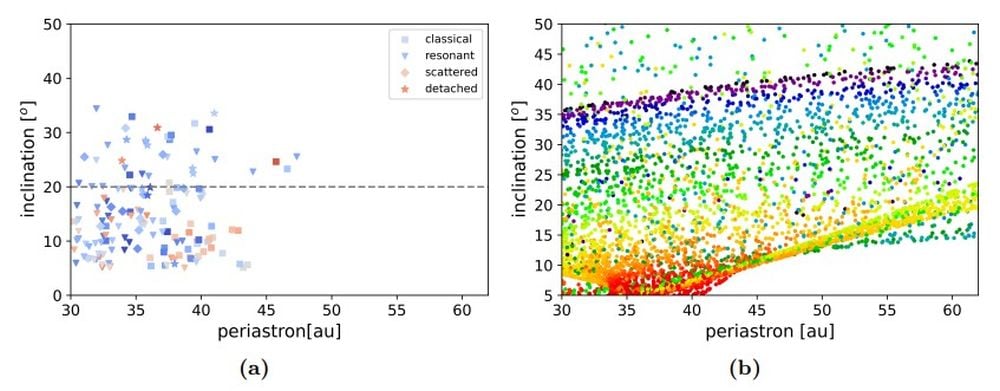 This figure shows scatter plots of the TNOs’ inclination as a function of periastron distance.(a) shows observational data from other research for TNO orbital inclinations by periastron distance. (b) shows the simulation results. Image Credit: Pfalzner et al. 2025. The Astrophysical Journal Letters.
This figure shows scatter plots of the TNOs’ inclination as a function of periastron distance.(a) shows observational data from other research for TNO orbital inclinations by periastron distance. (b) shows the simulation results. Image Credit: Pfalzner et al. 2025. The Astrophysical Journal Letters.The researchers ran the simulation for one billion years, and the simulation showed that the perturber’s effects became negligible by 12,000 years after periastron.
“After 1 Gyr, the overall structure is similar, with very red objects remaining rare among high-inclination and high-eccentricity TNOs,” the researchers write. They also explain that the colour patterns grow less distinct. Eventually, some red particles are ejected from the Solar System and others are shifted to high inclinations. “The distinct differences in the colour distributions between low- and high-inclination, as well as low- and high-eccentricity TNOs, persist,” they explain.
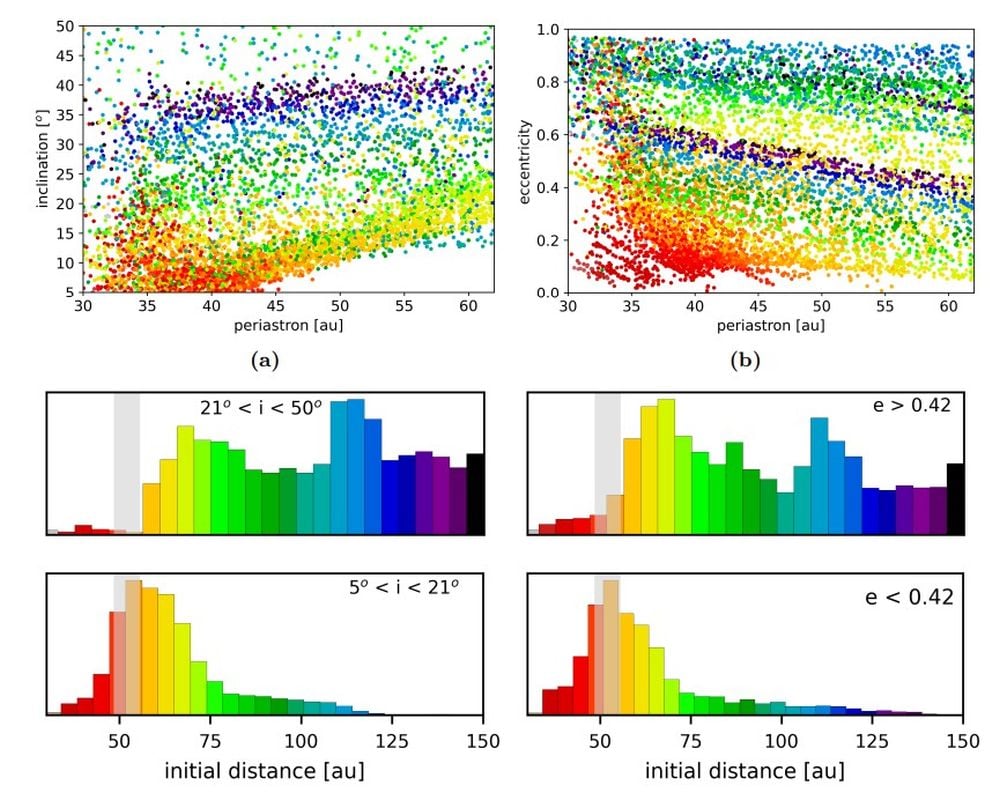 This figure shows the long-term evolution of TNO orbits one billion years after periastron. (a) shows the connection between TNO colours and inclinations. (b) shows eccentricities, while (c) and (d) show the corresponding colour distributions. Image Credit: Pfalzner et al. 2025. The Astrophysical Journal Letters
This figure shows the long-term evolution of TNO orbits one billion years after periastron. (a) shows the connection between TNO colours and inclinations. (b) shows eccentricities, while (c) and (d) show the corresponding colour distributions. Image Credit: Pfalzner et al. 2025. The Astrophysical Journal LettersThe effort to understand our Solar System’s Trans-Neptunian Objects and their history will get a boost when the Vera Rubin Observatory begins its ten-year Legacy Survey of Space and Time (LSST). It could increase the number of known TNOs by ten times. That data will lead to a deeper, fuller understanding of the TNO population.
One way to verify their simulation’s accuracy is to use it to predict what the LSST will find. “In anticipation of this, we try to predict the colours of these soon-detectable TNOs from a flyby perspective,” the authors write. They focus on distant TNOs in this case, since they’re more likely to be spotted by the LSST. They say that if they’re correct, distant TNOs will be predominantly light red to shades of grey, while there will be a notable lack of bright red objects.
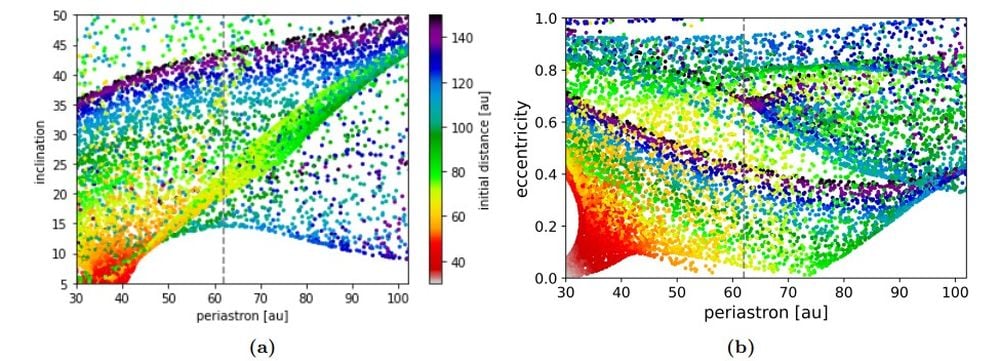 These panels show anticipated results from the LSST. (a) shows inclinations, while (b) shows eccentricities for TNOs with perihelion distances greater than 60 au. Image Credit: Pfalzner et al. 2025. The Astrophysical Journal Letters.
These panels show anticipated results from the LSST. (a) shows inclinations, while (b) shows eccentricities for TNOs with perihelion distances greater than 60 au. Image Credit: Pfalzner et al. 2025. The Astrophysical Journal Letters.The different colours of TNOs indicate the presence of different chemicals. In some cases, these chemicals have been weathered and altered, but the colours still constitute a strong clue about their origins and allow astronomers to track their evolution. This research shows that a stellar flyby can explain how TNOs have been shepherded into their unusual orbits.
“Assuming an initial colour gradient in the Sun’s debris disc, we found that the flyby accounts for the observed colour correlations from the OSSOS and DES surveys,” the researchers explain. “This simultaneous explanation of the TNO dynamics and colours significantly strengthens the argument for a stellar flyby largely determining the structure of the Solar System beyond Neptune,” they conclude.
Continue Reading
-

Jennifer Aniston says no to second chances with exes
Jennifer Aniston looking for ‘something real’ Jennifer Aniston, famously known for her role in Friends, is not open to reuniting with her exes.
As reported by RadarOnline, the sources have revealed that while Aniston has turned to her close pals Adam Sandler and his wife Jackie to play cupid in her love life, she is not willing to reunite with any of her exes.
The source said, “There’s no going backward for Jen.”
“She’s not into second chances with exes, and she doesn’t want to be someone’s trophy girlfriend. She’s after something real,” they added.
Aniston’s exes includes her ex-husbands Brad Pitt and Justin Theroux, and her famous ex-boyfriends Vince Vaughn and John Mayer.
Although she told an insider that “I trust Adam and Jackie more than anyone when it comes to this. They know me better than I know myself,” the source revealed that the Friends alum is not rushing to find love.
“She’s not pressuring Adam and Jackie—there’s no deadline. She’s open to the process and knows it might take time,” the source added.
They noted, “Jen’s been through a lot, but she still believes in love.”
“She just needs the right introduction—and that’s exactly what Adam and Jackie hope to give her,” the tipster said.
It is worth mentioning that this comes amid rumours of the actress dating a hypnotherapist Jim Curtis.
An insider told People Magazine that Jennifer Aniston and Curtis are dating “but it’s still casual.”
Continue Reading
-

Benefit of Ambroxol on Parkison Disease Dementia Unclear – Docwire News
- Benefit of Ambroxol on Parkison Disease Dementia Unclear Docwire News
- Randomized Trial Highlights Uncertainties of Ambroxol to Improve Cognition in Parkinson Disease Dementia NeurologyLive
- Cough Medicine May Protect Against Some of Parkinson’s Worst Symptoms ScienceAlert
- Cough Syrup Slows Brain Damage in Parkinson’s Dementia, Study Finds SciTechDaily
- A cough medicine may help slow down cognitive decline in Parkinson’s Medical News Today
Continue Reading
-

Video shows Palestinians caught in gunfire near GHF aid hub in Gaza
LONDON: On Beirut’s congested roads, where traffic crawls and crumbling infrastructure testifies to decades of neglect, a new rhythm is quietly taking shape.
Sleek, navy-blue buses — equipped with GPS, air conditioning and modern fare systems — now trundle through the city’s chaos, offering a welcome glimpse of efficiency. Whether they can truly deliver long-term impact, however, remains uncertain.
Cars crowd a road during a traffic jam in Beirut on October 14, 2024. (AFP)
For decades, Lebanon’s public transportation system has been an informal patchwork dominated by private minibuses and shared taxis. Now, the government is attempting to reassert control through a partnership with a private company aimed at modernizing the daily commute.
The new fleet operates on 11 routes, primarily across Greater Beirut, but also extending to parts of northern, southern and eastern Lebanon. A private logistics firm, Ahdab Commuting and Trading Co., manages day-to-day operations under a public-private partnership model.
FASTFACTS
• France donated 50 of the buses currently in use across Greater Beirut and beyond.
• A network of private vans and minibuses run fixed routes without schedules or stops.
• The 2024 Israel-Hezbollah conflict damaged Lebanon’s transport infrastructure.
While the initiative shows promise, commuters are aware of its limitations.
“Overall, you’ll mostly notice the impact of public transit inside the major cities, but even there, the system still heavily relies on taxis,” Mohammed Ali Diab, a Beirut-based journalist, told Arab News.

Beirut’s new buses aim to ease pressure on a public transit system long dominated by private minibuses and shared taxis, left. (Supplied & AFP file)
“Most taxis operate on a shared-ride basis unless a passenger specifically requests a private ride.”
Passengers typically say “service” to request a shared taxi, paying a flat fare — usually around 200,000 Lebanese pounds, or $2 — while the driver continues picking up others along the same route.
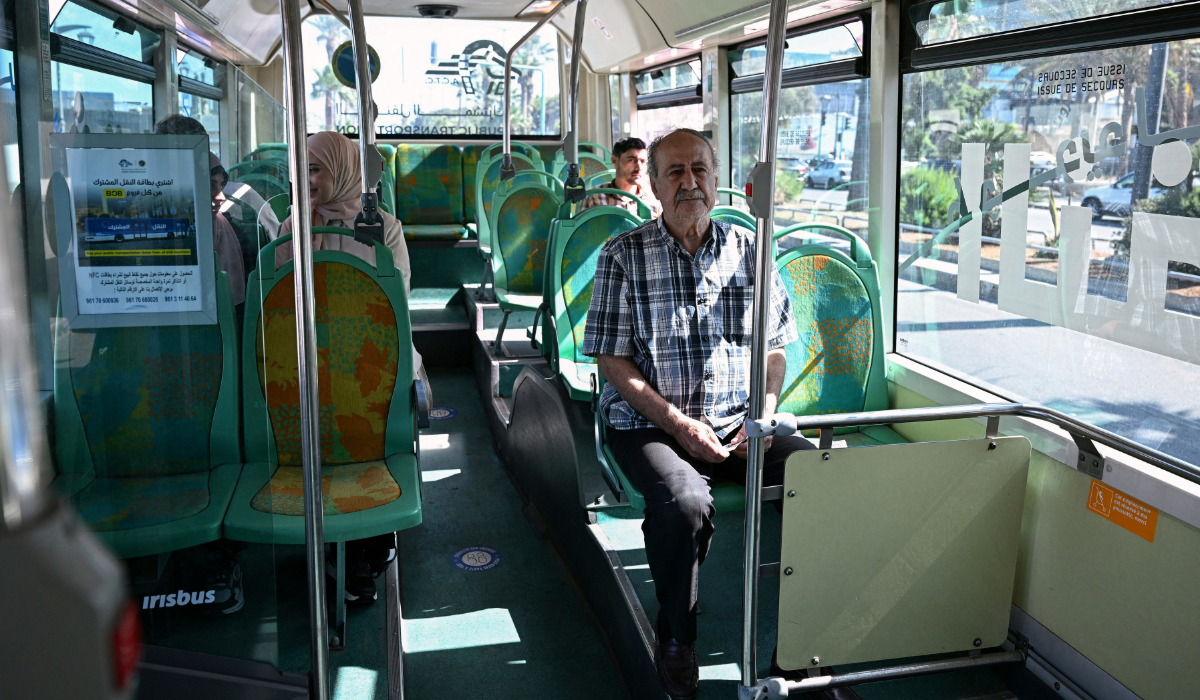
Passengers sit in a public transportation bus in Beirut on May 28, 2025. (AFP)
“In Beirut, there are also vans, but their routes are limited and fixed,” Diab added. “They don’t operate citywide.”
These vans and buses, he noted, are primarily used by working-class commuters and students, largely due to their affordability.

We took a risk during a difficult time and invested in a project that’s close to our hearts … We’re hopeful it will succeed, says Aoni Ahdab, CEO, Ahdab Commuting and Trading Co.
Beyond Beirut, shared taxis and buses connect major cities such as Tripoli, Tyre and Sidon. But in rural and mountainous regions, Diab said, residents still depend on private cars.
That dependence is becoming increasingly unviable. The World Bank’s Beirut office recently warned that Lebanon’s “reliance on private vehicles is increasingly unsustainable,” particularly amid rising poverty rates and vehicle-operation costs.

A public bus awaits passengers at a bus stop in Beirut on May 28, 2025. (AFP)
Lebanon is reeling from one of the world’s worst economic crises since 1850, according to the World Bank. Since 2019, currency collapse and high inflation have wiped out savings, shrunk incomes and pushed millions of people into poverty.
A 2024 World Bank report revealed that poverty has more than tripled over the past decade, now affecting 44 percent of the population. A separate study by Walid Marrouch, an economics professor at the Lebanese American University, found that at least 60 percent of citizens live below the poverty line.

A picture taken from Dbayeh north of Beirut on June 7, 2019, shows the skyline of the Lebanese capital covered in smog at sunset. (AFP)
Against this economic backdrop, the government’s partnership with ACTC represents a promising policy shift.
In 2023, the company won a competitive bid launched by the Ministry of Public Works to operate the bus system under specific contractual conditions. As part of the deal, ACTC contributes 10 percent of its revenues to the ministry.

Passengers sit in a public transportation bus in Beirut on May 28, 2025. (AFP)
Despite the financial risks, ACTC leaders believe in the project’s potential. “We took a risk during a difficult time and invested in a project that’s close to our hearts — one we believe adds real value to the country,” Aoni Ahdab, the ACTC CEO, told Lebanese media. “We’re hopeful it will succeed.”
The service officially launched in July 2024, despite regional instability and periodic hostilities between Israel and the militant group Hezbollah that temporarily disrupted routes. Israel’s escalation of attacks from September through late November did not halt the project.
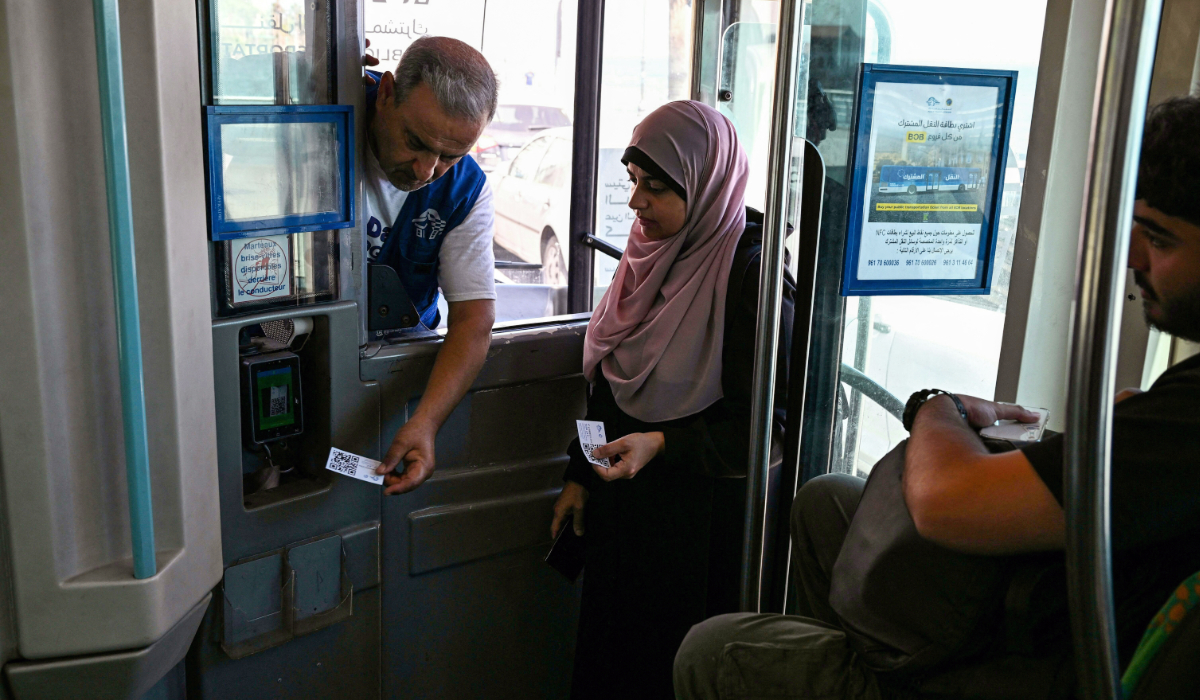
The driver helps a passenger to validate her ticket at a public transportation bus in Beirut on May 28, 2025. (AFP)
The 2024 conflict caused heavy damage to Lebanon’s transport infrastructure. The World Bank estimates $1 billion is needed for infrastructure sectors, including transport, within an $11 billion national recovery plan.
Much of the new fleet’s foundation was laid earlier. In 2022, France donated 50 buses to Lebanon, with more expected. Meanwhile, the Railway and Public Transport Authority refurbished 45 vehicles locally, raising the operational fleet to 95 — a modest but tangible effort to ease the transportation burden.
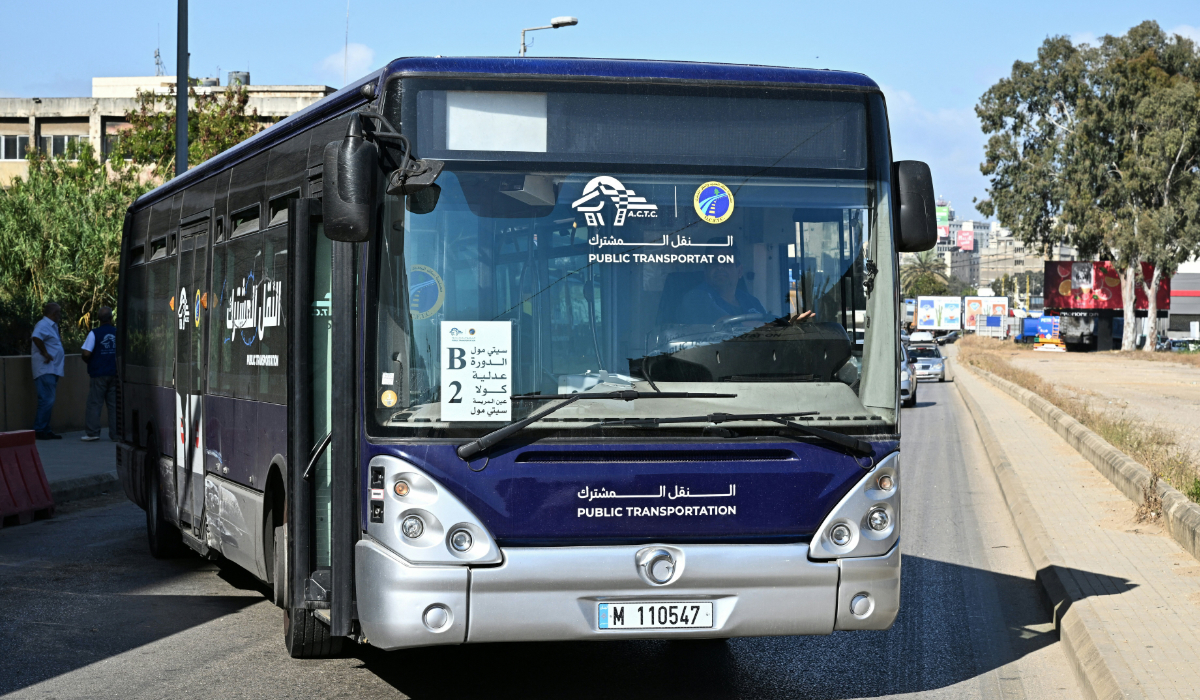
A public bus drives at a street in Beirut on May 28, 2025. (AFP)
Although the ACTC contract did not mandate fleet upgrades, the company voluntarily refurbished and standardized the buses, repainting them in navy blue for easy identification and installing safety and tracking technologies.
To test viability, a pilot phase launched in April. Buses operated from 6 a.m. to 7 p.m. daily to assess travel times, stop durations and operational needs. The goal was to ensure departures every 25 minutes.
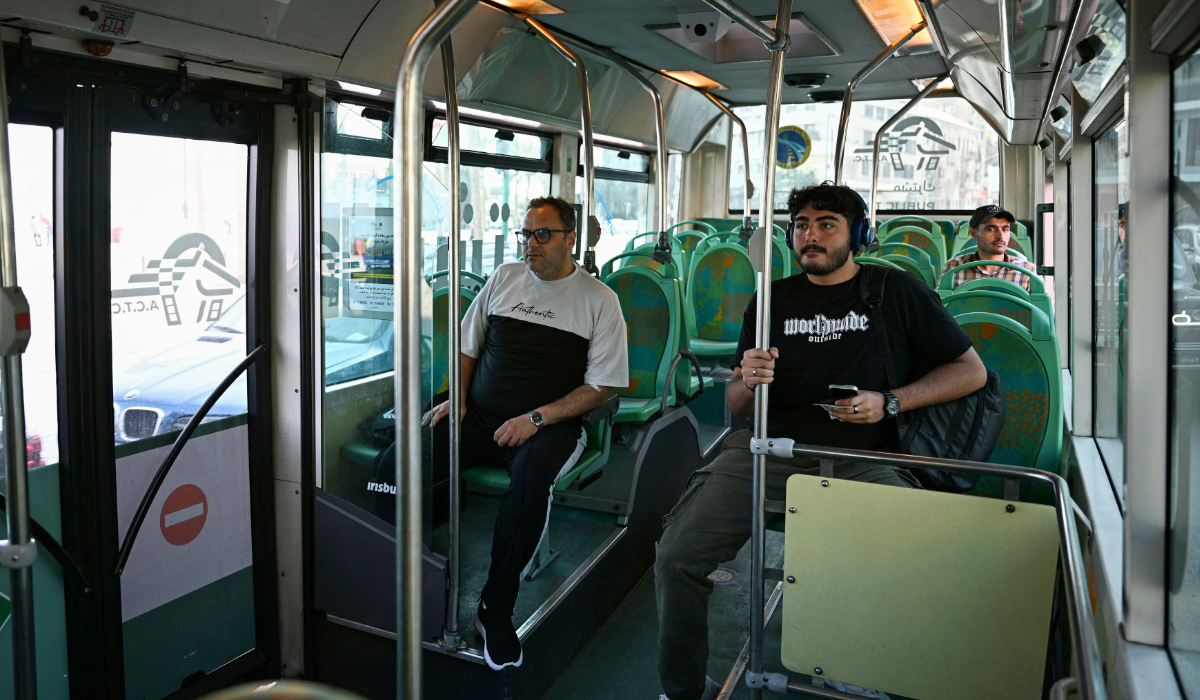
Passengers sit in a public transportation bus in Beirut on May 28, 2025. (AFP)
Pricing was designed to be accessible. Fares vary by distance: 70,000 Lebanese pounds within Beirut, 100,000 to Baabda, and 150,000 to Tripoli, according to local passengers.
Riders can purchase single-use tickets or opt for rechargeable cards. For now, those without cards can still pay drivers directly and receive a scannable paper ticket.
As Beirut confronts long-standing infrastructure challenges, this initiative is viewed as cautious progress. Yet its success will depend on earning public trust and expanding service sustainably.
Initial data is encouraging. Ziad Nasr, head of Lebanon’s public transport authority, told AFP last month that daily ridership has risen to around 4,500 passengers, up from just a few hundred at launch.
Authorities hope to expand service further, including routes to Beirut’s airport, but additional buses and international support will be needed.
However, the rollout has not been smooth. Resistance from private transport operators, who view the initiative as a threat to their livelihoods, has been fierce.
According to local media, several buses were vandalized and drivers, especially on the Adlieh–Hadath University Campus route, faced threats and harassment toward the end of 2024. The Ministry of Public Works and security forces intervened to keep services running.
These tensions are symptomatic of deeper, long-standing issues. Lebanon’s public transport sector has suffered for decades from weak oversight, overlapping private interests, chronic underfunding, and lack of strategic planning — all of which have repeatedly hindered reform efforts.
The roots of dysfunction stretch back to the civil war of 1975–1990, which devastated infrastructure and governance. In the years that followed, a car-dependent culture took hold. Even before the 2019 economic collapse, Lebanon was already struggling with failing power grids, unsafe roads and limited water access.
Beyond reducing congestion and improving mobility, public transportation could also play a key role in environmental reform — an often overlooked priority in Lebanon. A World Bank climate and development report noted that the transport sector is the country’s second-largest source of greenhouse gas emissions and air pollution, second only to the energy sector.
Indeed, in cities like Beirut, poor air quality is a growing concern. Frequent traffic jams and widespread use of diesel-powered generators — especially during routine blackouts — have worsened pollution and related health risks.
On the upside, there are signs of innovation. In Zahle, east of Beirut, four hybrid buses are already operating, Nabil Mneimne of the UN Development Program told AFP in June.
More progress is expected this year. Lebanon’s first fully electric buses, powered by a solar charging system, are set to launch between Beirut and the northern city of Jbeil.
A longer-term roadmap for reform has also been laid out. A 2022 World Bank report on improving public transport in Lebanon, Jordan, and Iraq outlined key recommendations. These included unifying bus operators, creating a fund to buy back public licenses, implementing intelligent transport systems, and developing a national road safety strategy.
The report also urged the government to adopt “quick-win” solutions to improve the user experience — such as reliable schedules, journey-planning apps, real-time tracking, and updated data to enable effective planning.
Together, these steps could help Lebanon transform its transportation landscape — if the political will and public support can be sustained.
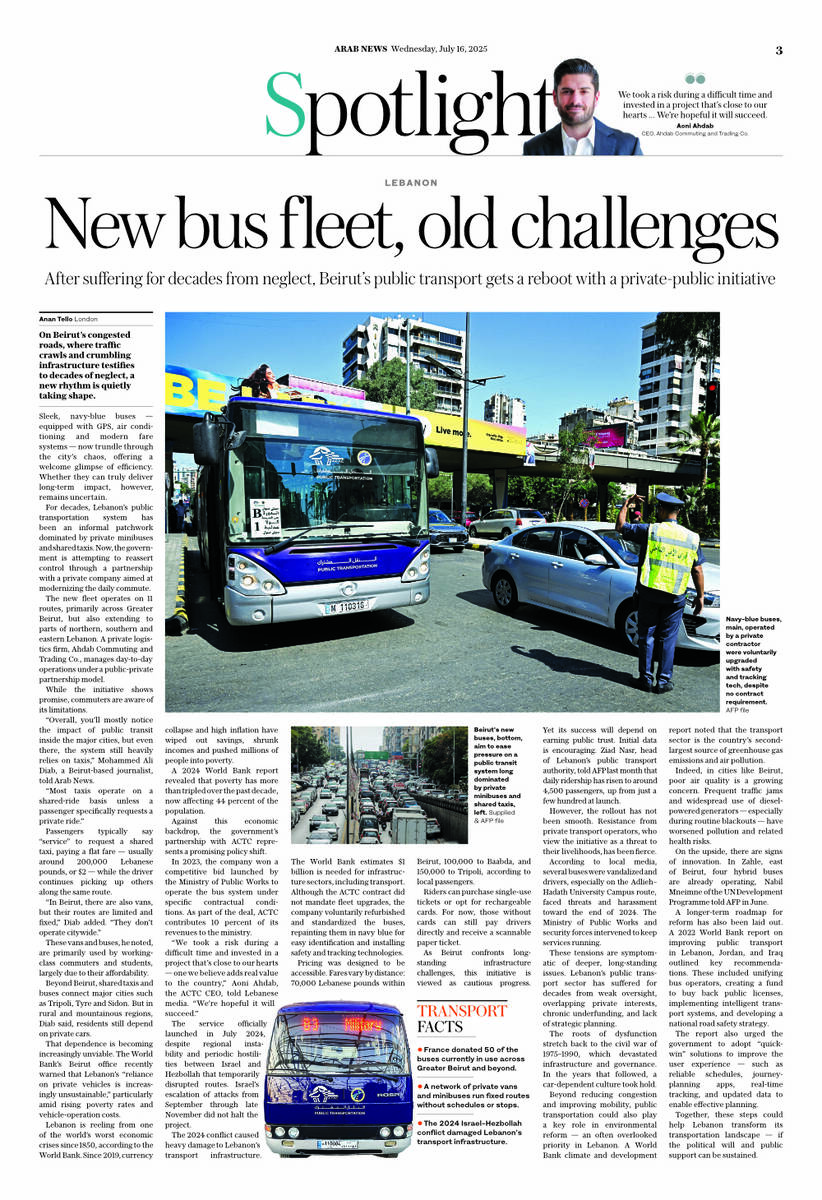
Continue Reading
-

Defending champ Badosa pulls out of Washington with lower back injury
Defending champion Paula Badosa has withdrawn from next week’s Mubadala Citi DC Open with a lower back injury.
Writing on X, the world No. 10 clarified that she’s currently struggling with a psoas tear, and will be out of action for “a few weeks.”
“I’m going through a really tough time,” the world No. 10 wrote. “Sometimes everything feels like a tunnel with no way out … but if I’ve always proven one thing, it’s that I never stop fighting.”
In a follow-up post, she added, “I want to sincerely thank all the people who are sending me their support, love, and energy during these difficult days. That encouragement sustains me and gives me the strength to keep going, even when everything seems uphill. Thank you for being there.”
Hola a todos,
Debido a una rotura del psoas voy a tener que estar fuera de competición unas semanas.
Estoy pasando por momentos realmente duros. A veces todo se siente como un túnel sin salida… pero si algo he demostrado siempre, es que nunca dejo de luchar.— Paula Badosa (@paulabadosa) July 14, 2025
In her absence, Queen’s Club champion Tatjana Maria has moved into the main draw.
Badosa’s withdrawal comes on the heels of a disappointing showing at Wimbledon, where she was upset by Britain’s Katie Boulter in the first round at the All England Club.
This has become an unfortunate trend for the former world No. 2, whose chronic back injury forced her to pull out of Madrid and Miami mid-tournament earlier this year. She was also forced to withdraw from Indian Wells.
The hope is that the 27-year-old Spaniard will be in form for the upcoming US Open, where she reached the quarterfinals a year ago. She’s also committed to partnering with Stefanos Tsitsipas in the revamped US Open Mixed Doubles Championship at Flushing Meadows, which is scheduled for August 19th and 20th.
Despite Badosa’s withdrawal, the 500-level event in D.C. — main-draw play kicks off on Monday, July 21 — remains loaded with top talent. World No. 4 Jessica Pegula tops the field, and she’ll be joined by world No. 11 Emma Navarro, world No. 6 Zheng Qinwen, and former Grand Slam champions Emma Raducanu, Elena Rybakina, and Sofia Kenin. Seven-time Grand Slam champion Venus Williams, 45, is also making her highly-anticipated return to action after accepting a main-draw wild card.
Continue Reading
